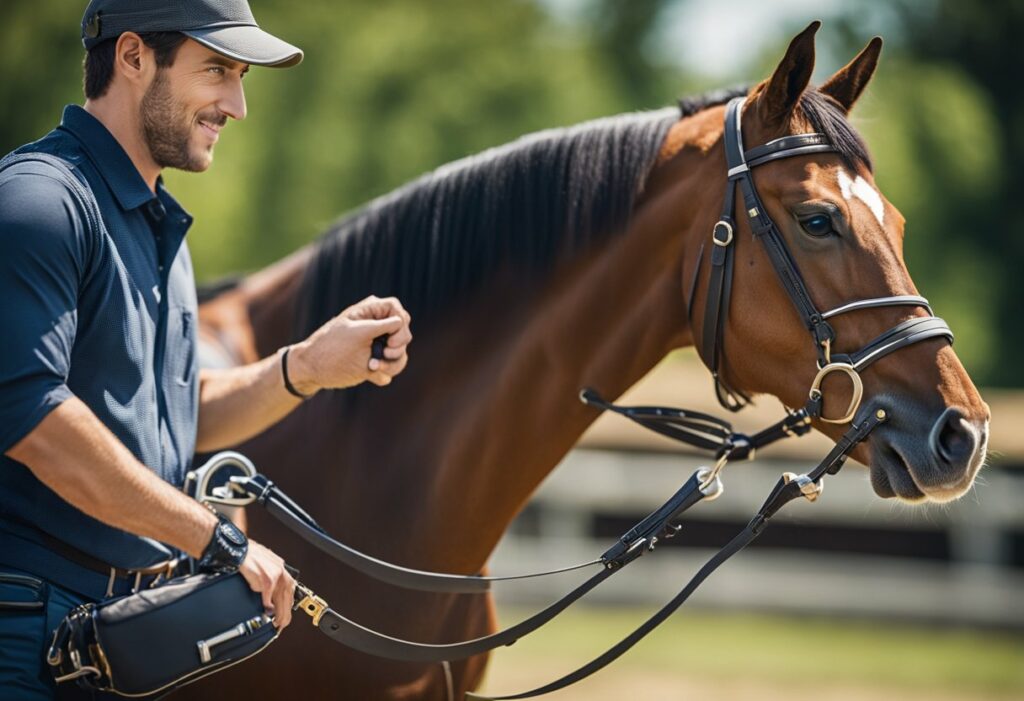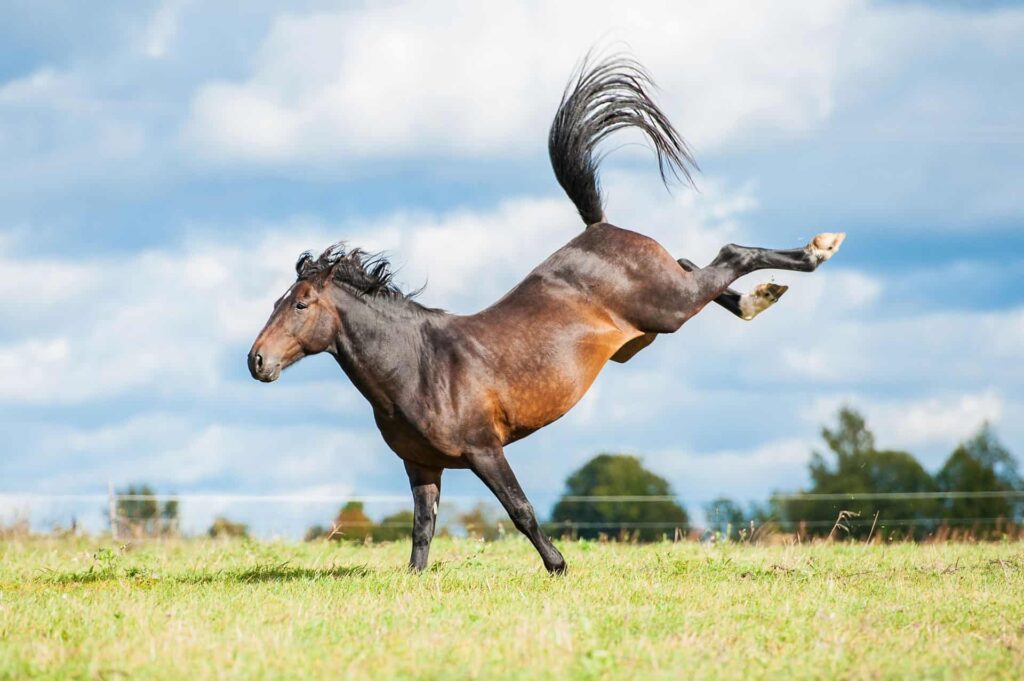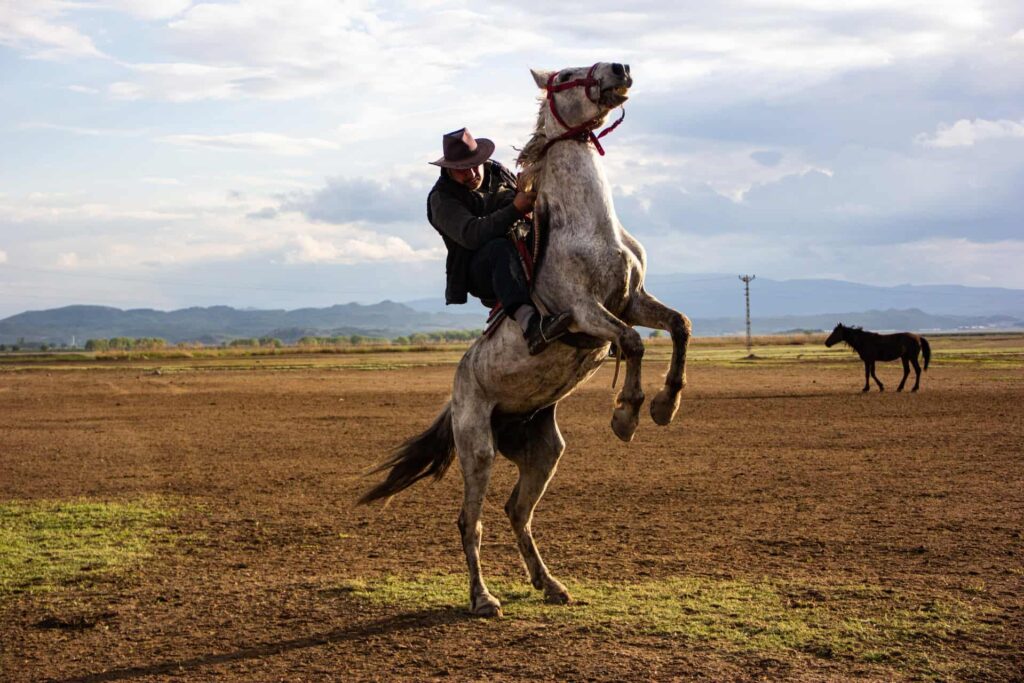Horse clicker training is a popular method of teaching and reinforcing desired behaviors in horses. It is based on the principles of positive reinforcement and operant conditioning, where the horse is rewarded for performing specific actions, making it more likely that the behavior will be repeated in the future. By using a clicker as a secondary reinforcer, the trainer can communicate effectively with the horse by marking the precise moment the horse performs the desired behavior, which in turn leads to a more enjoyable and efficient learning experience for both the horse and the trainer.
Clicker training has been successfully applied in the training of various animals, including horses, to achieve a wide range of goals. The method primarily focuses on teaching the horse to associate the sound of the clicker with a primary reinforcer, like food or a favorite treat. The trainer can then use the clicker in conjunction with specific cues to guide the horse through a series of desired actions or responses. This approach has numerous advantages over traditional training methods, including improved communication, increased motivation, and a more engaged learning experience.
Key Takeaways
- Horse clicker training utilizes positive reinforcement and a clicker to effectively teach desired behaviors
- This training method enhances communication and motivation between the trainer and the horse
- Clicker training offers a more enjoyable and efficient learning experience compared to traditional training methods
The Concept of Horse Clicker Training
Understanding Clicker Training
Clicker training is a method of training horses that uses positive reinforcement to shape their behavior. This approach is based on the principles of operant conditioning and emphasizes the use of a secondary reinforcer, the clicker, to mark the desired behavior. The clicker serves as a clear and consistent signal to the horse that it has performed the correct action and is then followed by a primary reinforcer such as food or praise. This method helps build a strong connection between the horse and its trainer and allows for efficient and humane training of various tasks and skills.
Clicker training has its roots in natural horsemanship and seeks to work with the horse’s natural instincts and communication signals. It promotes a partnership between horse and trainer, fostering trust and understanding, while minimizing the use of force or punishment. Horses trained using clicker training methods have been shown to demonstrate an increased willingness to learn and exhibit a higher level of emotional well-being during training sessions.
Breaking Down the Behavior
When using clicker training, the first step is to teach the horse the meaning of the clicker as a secondary reinforcer. This is achieved through a process known as “charging the clicker,” in which the trainer repeatedly pairs the click with a primary reinforcer, such as food until the horse begins to associate the sound of the click with the reward. Once the horse understands the significance of the clicker, the trainer can use it to shape specific behaviors.
A key component of clicker training is the process of breaking down complex behaviors into smaller, more manageable steps, called “shaping.” This involves gradually guiding the horse towards the desired behavior by reinforcing successive approximations, or small steps, in the right direction. For example, a trainer wishing to teach a horse to lower its head on command may initially reward the horse simply for looking towards the ground, and then build upon this success by holding out for a slightly lowered head before clicking and rewarding. As the horse demonstrates an understanding of each step, the trainer can gradually raise the criteria and move towards the final goal behavior.
By using clicker training and positive reinforcement, horses can benefit from a clear, consistent, and non-punitive approach to learning that fosters a strong bond between horse and trainer. As a result, clicker-trained horses are often considered more responsive and eager to engage in the learning process, making this training methodology an effective and humane choice for building lasting partnerships with these majestic animals.
Fundamental Aspects of Clicker Training
Clicker training is a powerful technique for teaching horses new behaviors, as it relies on positive reinforcement, which strengthens the bond between horse and trainer. In this method, a small device called a clicker acts as a marker, signaling to the horse exactly when it performed the desired behavior. The clicker is often followed by a reward, typically food, which reinforces the horse’s motivation to repeat the behavior in anticipation of another reward.
The foundation of clicker training lies in the clear communication of cues and consistent reinforcement. The trainer first introduces a cue, either vocal or physical, which indicates the desired behavior. Once the horse responds appropriately, the trainer instantly uses the clicker to mark the moment of success and soon after provides a food reward as a reinforcer. This sequence teaches the horse to associate the cue with the desired behavior and the clicker acts as a bridge connecting the behavior to the reward.
Incorporating targeting and shaping techniques enables trainers to gradually develop complex behaviors or refine existing ones. With targeting, the horse is taught to touch or follow a handheld target, such as a stick or a cone, which can be used to direct its movements. Shaping involves breaking down a behavior into smaller steps and rewarding progress toward the final goal. As the horse masters each step, the trainer gradually raises the criteria for reinforcement.
The key to successful clicker training lies in consistency and timing. It is important to mark the desired behavior with the clicker as soon as it occurs and to promptly deliver the reward. This precise timing ensures that the horse makes the correct association between the cue, the clicker, and the reinforcement. Failure to maintain consistency can result in confusion and slower progress.
Clicker training offers a valuable alternative to traditional training methods that often rely on negative reinforcement or punishment. By focusing on positive reinforcement, clicker training promotes a strong bond between horse and trainer, as well as enhancing the horse’s enthusiasm and willingness to learn. The horse becomes an active participant in training, eager to offer behaviors in search of a reward, leading to a more enjoyable and effective learning experience.
Clicker training requires patience, commitment, and an understanding of equine behavior. By utilizing the fundamental aspects of clicker training, such as clear cues, accurate marker timing, and consistent reinforcement, trainers can effectively and compassionately guide their horses toward new skills and behaviors while fostering a strong, positive relationship.
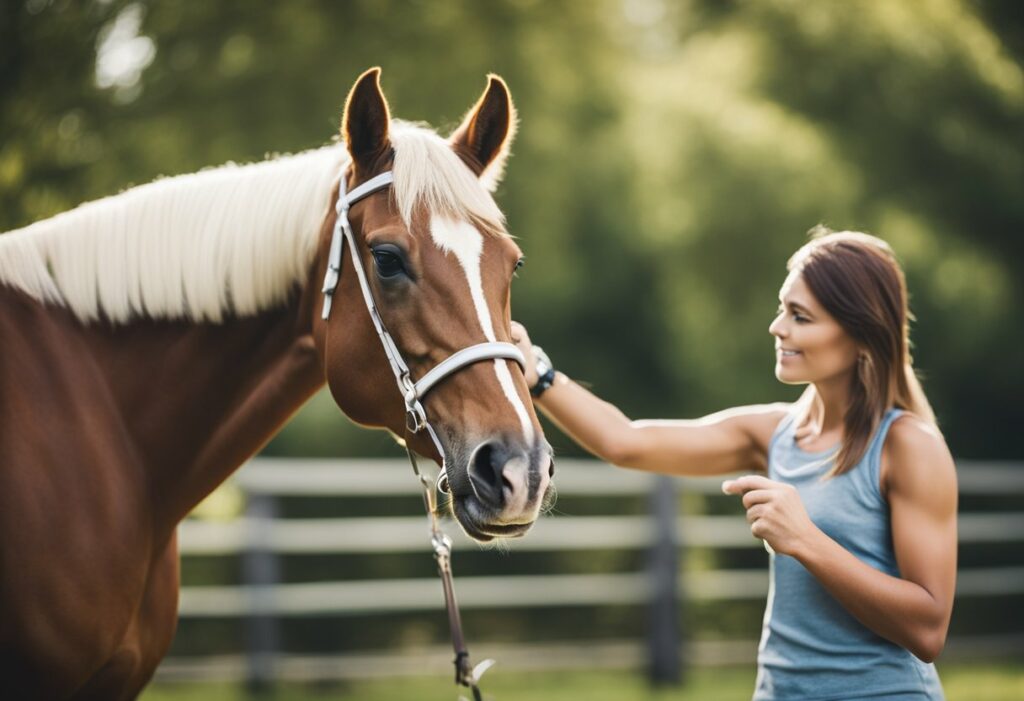
Techniques in Horse Clicker Training
Horse clicker training, a method rooted in operant conditioning and positive reinforcement, focuses on developing trust and communication between the equestrian and their horse. The foundation of this technique lies in utilizing a handheld clicker device to signal when the horse performs a desired behavior.
To begin, it is important for the trainer to establish proper timing in their clicker use. When the horse exhibits the desired behavior, such as a change in body weight, a nudge, or responding to a verbal cue, the trainer must provide a clear, concise click, followed by a reward. This conditioning process helps the horse understand the connection between the clicker sound, their action, and the awaiting reward.
Safety is paramount during horse clicker training. Having the horse in a calm and relaxed state helps to mitigate any abrupt reactions or potential injuries. For this reason, trainers should start by introducing simple exercises that do not require complex actions or trick training, such as the following:
- Head lowering: Encourage the horse to lower its head by applying gentle downward pressure on the halter or reins, followed by a click and treat when the desired position is achieved.
- Manners: Teach the horse to stand still, refrain from sniffing, and avoid invading personal space through consistent marker use and rewarding appropriate behavior.
- Verbal cues: Pair vocal cues with clicker and treat to help the horse understand the expected response, such as “walk,” “halt,” or “back up.”
When the horse becomes familiar with the clicker’s purpose, trainers can gradually incorporate more challenging exercises into the training sessions. Progressing in this manner allows the horse to build trust and improve communication with their handler.
An aspect of clicker training is breaking down complex actions into smaller, achievable steps. For instance, if teaching a horse to bow, trainers should initially reward any weight shift towards the desired position. As the animal demonstrates comprehension, gradually increase the complexity of the response expected before initiating a click and treat.
By consistently implementing clicker training within a horse’s normal routine, its understanding of both verbal and non-verbal cues will improve. Consequently, this will reinforce the positive behaviors and manners exhibited during training sessions.
Horse clicker training combines markers, verbal cues, and positive reinforcement to establish trust and communication between the equestrian and their horse. By incorporating this method into the animal’s regular routine, trainers can effectively shape their horse’s behavior, enhance riding experiences, and foster a lasting bond.
Using Tools
Clicker training is a powerful and efficient method for teaching horses new behaviors using positive reinforcement. To get started with horse clicker training, you’ll need a few tools: a clicker, a target stick, and a treat pouch.
A clicker is a small handheld device that produces a consistent and distinctive clicking sound when pressed. This sound serves as a marker, informing the horse that it has performed the desired behavior and that a reward is coming. Clickers are widely available online or at pet supply stores, and they come in various shapes and sizes to suit individual preferences. The key is to find one that you can comfortably hold and operate while working with your horse.
The target stick is another crucial tool for clicker training. It’s a long stick with a brightly colored tip that the horse learns to touch with its nose. This helps guide the animal towards the desired behavior and can be useful in teaching everything from simple target touching to more advanced movements and tricks. When selecting a target stick, look for one that is lightweight, easy to grip, and has an eye-catching tip that will encourage the horse’s attention.
A treat pouch serves as a convenient way to carry and dispense rewards during training sessions. Positive reinforcement relies on delivering treats promptly as a reward for the desired behavior, so having them easily accessible is great! Treat pouches come in various designs, with some featuring a belt clip or waistband attachment for hands-free use, while others have drawstring closures to keep treats securely stored. Choose a design that works best for your needs and allows you to quickly reward your horse’s progress.
Using these clicker training tools effectively requires a solid understanding of how to apply positive reinforcement and timing. Begin by establishing a strong foundation of trust and communication with your horse, ensuring they are receptive to the training process. Once you have built this relationship, consistent practice with your clicker, target stick, and treat pouch will lead to successful and efficient horse training experiences.
Horse Behaviour Management Using Clicker Training
Clicker training is a positive reinforcement method that has become increasingly popular for managing horse behavior. This training technique utilizes a marker signal, such as a click sound, to indicate the horse has performed a desired behavior. When used correctly, clicker training can effectively address common equine behavior issues, build confidence and trust, and enhance the overall training experience.
One issue that can arise in horses is biting or mugging behavior. This occurs when a horse nudges or nips at the handler, often seeking treats. A study found that the combination of hand-feeding titbits and clicker training can help to reduce these unwanted behaviors. By associating the clicker sound with the delivery of a food reward, the horse learns to wait patiently for the treat rather than engaging in mugging actions.
Another aspect of horse behavior management where clicker training can be advantageous is building confidence and trust between the horse and handler. Research has shown that clicker training, with its low cost and ease of application, can lead to faster learning and more positive responses from horses. By focusing on rewarding good behavior, the horse begins to associate the handler with positive experiences, which in turn strengthens the bond and trust between them.
In addition to addressing behavioral issues, clicker training can also be used to teach new skills, such as lateral work, which is important for advanced riding and dressage. Lateral work involves moves like side-stepping and diagonals, which can be challenging to teach through traditional methods. With clicker training, the handler can break down the lateral movements into smaller parts, rewarding the horse with each successful step. This incremental training approach encourages the horse to seek the correct position or movement, thus making the learning process more enjoyable and effective.
Clicker training offers a versatile and positive approach to horse behavior management by using a clear marker signal and rewarding desired behaviors. This method can help address equine behavioral issues, build confidence and trust, and serve as an effective teaching tool for new skills.
Incorporating Into Regular Horse Training
Clicker training is a positive reinforcement technique that can be effectively incorporated into regular horse training. Initially, it might seem challenging to adopt this method – inspired by The application of learning theory in horse training – but with careful planning, the transition can be smooth.
To begin with, trainers must understand the mechanics of clicker training. A handheld clicker is used to mark the precise moment a horse exhibits a desired behavior. The click is immediately followed by a reward, like a treat, to reinforce the behavior. Over time, the horse associates the click with positive consequences, thus becoming more likely to repeat the action.
Duration is a crucial aspect of successful clicker training. Start with short sessions of about 5-10 minutes and gradually increase the length as the horse becomes familiar with the clicker. This prevents the horse from becoming bored or frustrated, ensuring a positive learning experience.
A practical application of clicker training is trailer loading. Traditionally, this process can be challenging for both horses and handlers. With clicker training, the horse is encouraged to approach and enter the trailer voluntarily. By breaking down the steps and rewarding the horse for each small progress, the horse becomes more comfortable with the trailer.
Incorporating clicker training into regular horse training involves patience and consistency. By gradually introducing the positive reinforcement technique, a strong foundation for learning can be built. Clicker training not only improves the horse’s behavior but also strengthens the bond between horse and trainer, fostering a positive and enjoyable training environment.
Ensuring Safety in Clicker Training Horses
Horse clicker training is a powerful, positive-reinforcement method for training horses and understanding their behavior. To make the most of this approach, prioritize safety for both the horse and the handler when conducting clicker training sessions.
First and foremost, handlers should establish a safe training environment. The training area should be free of hazards, such as sharp objects or unstable footing, which can cause injury to the horse or trainer. Additionally, the horse should be wearing appropriate gear, such as a properly fitted halter, to ensure control and prevent accidents.
Regular grooming and care are crucial to horse safety as well. Trimming the horse’s hooves is vital to prevent issues like uneven walking or potential injuries, as an overgrown or damaged hoof can result in discomfort and instability. Proper grooming also helps to maintain overall horse health, making them more receptive to training.
In the early stages of clicker training, establish clear boundaries and maintain a respectful distance from the horse. This allows the horse to understand the handler’s intentions and prevents any accidental nipping or striking. Handlers should always be attentive to the horse’s behavior and adjust their approach accordingly, ensuring a low-stress and positive environment for learning.
A key aspect of safety during horse clicker training is recognizing signs of stress or fear in the animal, as these emotions can manifest in aggressive or dangerous behavior. Handlers should be observant and sensitive to changes in the horse’s demeanor, such as pinned ears, raised tails, or sudden movements, and should modify their approach or take a break if the horse seems uneasy.
Lastly, the use of protective gear, such as gloves and helmets, is recommended for handlers engaging in horse clicker training, especially during the initial stages or when working with a new horse. This gear can provide invaluable protection in the event of a sudden or unexpected reaction from the horse.
Overall, ensuring safety in horse clicker training is a multifaceted effort that involves creating a secure environment, maintaining the horse’s health, and being aware of the animal’s behavior and cues. With these precautions in place, both the horse and handler can enjoy a productive and satisfying clicker training experience.
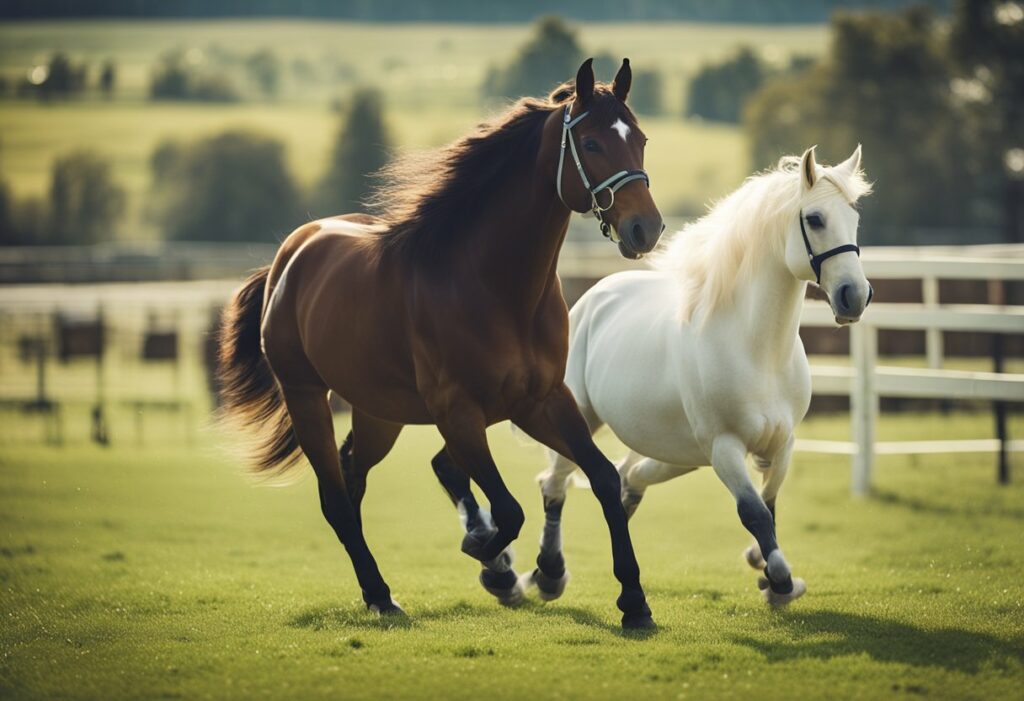
Clicker vs Traditional Training
Clicker training is based on the principles of classical conditioning and positive reinforcement. In this approach, a small device called a clicker is used to make a distinct sound, followed by a reward (usually a treat) to reinforce the desired behavior. This creates an association between the sound of the clicker and the positive outcome, making it an effective training tool for horses.
On the other hand, traditional training methods for horses often rely on negative reinforcement or punishment, like applying pressure or using aids to guide the horse’s behavior. This approach tends to create a more authoritarian relationship between the trainer and the horse and can sometimes lead to resistance, stress, and fear in the animal.
Clicker training has been reported to increase engagement, motivation, and retention in horses, as they actively participate in the learning process and receive positive reinforcement throughout. A study found that hand-feeding and clicker training was associated with lower incidences of unwanted behaviors, such as mugging when compared with traditional training methods.
Moreover, horses trained with clickers have been found to display improved problem-solving skills, better communication with their trainers, and a stronger bond between horse and trainer, as the clicker creates a clear signal for the desired behavior.
In a study comparing trainers’ reports of clicker use to the use of clickers in applied research studies, the analysis indicated that methodological differences may explain conflicting results. However, clicker training has been successfully applied to a wide range of animals, including dogs, cats, and even llamas, demonstrating its versatility and efficacy.
Traditional training methods can also be effective in teaching specific tasks and maintaining discipline, but they may not foster the same level of trust and communication between horse and trainer as clicker training does. The choice between clicker training and traditional training often depends on the individual goals and preferences of the trainer, as well as the specific needs and temperament of the horse.
Both clicker and traditional training methods have their merits, but clicker training offers a more positive, engaging, and communicative approach that can lead to stronger bonds between horse and trainer and improved learning outcomes.
Frequently Asked Questions
What are the essential supplies for horse clicker training?
Horse clicker training requires a few simple yet essential supplies. First, you will need a clicker, which is a small device that makes a consistent clicking sound to signal successful behavior. Second, you’ll need a variety of small, healthy treats that your horse finds appealing. Finally, it’s helpful to have a target stick, which can be used to direct your horse’s attention during training sessions.
How is The Willing Equine method related to clicker training?
The Willing Equine method is a form of positive reinforcement training that uses clicker training techniques to communicate with and train horses. It focuses on building a strong bond between the horse and trainer and emphasizes the importance of trust, consistency, and patience during training sessions.
What is target training and how is it used with horses?
Target training involves teaching a horse to touch a specific item, such as a target stick, with a specific body part, like their nose or hoof. In clicker training, target training is often used as a foundation for teaching more complex behaviors, as touching the target leads to a click and a subsequent reward.
How to teach a horse tricks using clicker training?
Teaching tricks to a horse using clicker training involves breaking the desired behavior into small, manageable steps. Start by rewarding any action that leads toward the final trick, gradually increasing the criteria for a reward as the horse progresses. Click and reward each successful attempt, and build on the previous steps, ensuring your horse masters each stage of the trick before moving on.
Which treats work best for clicker training sessions?
The best treats for clicker training sessions are small, easily consumed, and appealing to your horse’s palate. They should also be healthy and low in sugar. Soft treats, like small cubes of apple or carrot, are good options, as are low-calorie commercial horse treats designed specifically for training purposes.
What are the potential drawbacks or concerns with clicker training for horses?
Some potential drawbacks or concerns with horse clicker training include the possibility of mugging behavior, where the horse becomes overly focused on food rewards and may nudge or bite trainers seeking treats. This can be mitigated by establishing clear boundaries and carefully monitoring the horse’s behavior during training. Additionally, clicker training requires patience and consistency, as well as a thorough understanding of how to apply the principles of positive reinforcement effectively. Misapplication of these principles may set back progress or result in unwanted behaviors.
Last Updated on October 8, 2023 by Nate Dewsbury
